Organoarsenic chemistry
Organoarsenic chemistry is the chemistry of compounds containing a chemical bond between arsenic and carbon. A few organoarsenic compounds, also called "organoarsenicals," are produced industrially with uses as insecticides, herbicides, and fungicides. In general these applications are declining in step with growing concerns about their impact on the environment and human health. The parent compounds are arsine and arsenic acid. Despite their toxicity, organoarsenic biomolecules are well known.
History
Surprising for an area now considered of minor importance, organoarsenic chemistry played a prominent role in the history of the field of chemistry. The oldest known organoarsenic compound, the foul smelling cacodyl was reported in "cacodyl" (1760) and is sometimes classified as the first synthetic organometallic compound. The compound Salvarsan was one of the first pharmaceuticals, earning a Nobel prize for Paul Ehrlich. Various other organoarsenic compounds formerly found use as antibiotics (Solarson) or other medical uses.[1]
Synthesis and classification
Arsenic typically occurs in the oxidation states (III) and (V), illustrated by the halides AsX3 (X = F, Cl, Br, I) and AsF5. Correspondingly, organoarsenic compounds are commonly found in these two oxidation states.[2]
The hydroxyarsenic compounds are known:[2]
- arsonous acids (RAs(OH)2), rare (arsenous acid (As(OH)3) is well known)
- arsinous acids (R2AsOH), rare
- arsinic acids (R2As(O)OH), common, illustrated by cacodylic acid (R = CH3)
- arsonic acids (RAs(O)(OH)2), common, illustrated by phenylarsonic acid (R = C6H5)
Organoarsenic(V) chemistry and uses
Arsenic(V) compounds typically feature the functional groups RAsO(OH)2 or R2AsO(OH) (R = alkyl or aryl). Biomethylation of arsenic compounds starts with the formation of methanearsonates. Thus, trivalent inorganic arsenic compounds are methylated to give methanearsonate. S-adenosylmethionine is the methyl donor. The methanearsonates are the precursors to dimethylarsonates, again by the cycle of reduction (to methylarsonous acid) followed by a second methylation.[3] This dimethyl compound is Cacodylic acid ((CH3)2AsO2H), figures prominently throughout the chemistry of organoarsenic compounds. In contrast, the dimethylphosphonic acid is less significant in the corresponding chemistry of phosphorus. Cacodylic acid arises from the methylation of arsenic(III) oxide. Phenylarsonic acids can be accessed by the reaction of arsenic acid with anilines, the so-called Bechamp reaction.
The monomethylated acid, methanearsonic acid (CH3AsO(OH)2), is a precursor to fungicides (tradename Neoasozin) in the cultivation of rice and cotton. Derivatives of phenylarsonic acid (C6H5AsO(OH)2) are used as feed additives for livestock, including 4-hydroxy-3-nitrobenzenearsonic acid (3-NHPAA or Roxarsone), ureidophenylarsonic acid, and p-arsanilic acid. These applications are controversial as they introduce soluble forms of arsenic into the environment.
Compounds of arsenic(V) containing only organic ligands are rare, the pre-eminent member being the pentaphenyl derivative As(C6H5)5.[4]
Organoarsenic(III) chemistry and uses
Most such compounds are prepared by alkylation of AsCl3 and its derivatives using organolithium and Grignard reagents.[4] For example, the series trimethylarsine ((CH3)3As), dimethylarsenic chloride ((CH3)2AsCl), and methylarsenic dichloride (CH3AsCl2) is known. Reduction of the chloride derivatives with hydride reducing reagents affords the corresponding hydrides, such as dimethylarsine ((CH3)2AsH) and methylarsine (CH3AsH2). Similar manipulations apply to other organoarsenic chloride compounds.
An important route to dimethylarsenic compounds begin with reduction of cacodylic acid (see above):
- (CH3)2AsO2H + 2 Zn + 4 HCl → (CH3)2AsH + 2 ZnCl2 + 2 H2O
- (CH3)2AsO2H + SO2 + HI → (CH3)2AsI + SO3 + H2O
A variety of heterocycles containing arsenic(III) are known. These include arsole, the arsenic analogue of pyrrole, and arsabenzene, the arsenic analogue of pyridine.
Symmetrical organoarsenic(III) compounds, e.g. trimethylarsine and triphenylarsine, are commonly used as ligands in coordination chemistry. They behave like phosphine ligands, but are less basic. The diarsine C6H4(As(CH3)2)2, known as diars, is a chelating ligand. Thorin is an indicator for several metals.
Organoarsenic(I) compounds and uses
Least significant in terms of commercial uses and numbers are the organoarsenic(I) compounds. The anti-syphylic drugs Salvarsan and Neosalvarsan are representative of this class. These compounds typically feature three bonds to As, but only As-As single bonds. Compounds of arsenic(I) but containing As=As double bonds are rare.
Chemical warfare
Organoarsenic compounds, especially those featuring As-Cl bonds, have been used as chemical weapons, especially during World War I. Infamous examples include "Lewisite" (chlorovinyl-2-arsenic dichloride) and "Clark I" (chlorodiphenylarsine). Phenyldichloroarsine is another one.
In nature
As arsenic is toxic to most life forms and it occurs in elevated concentration in some areas several detoxification strategies have evolved. Inorganic arsenic and its compounds, upon entering the food chain, are progressively metabolized to a less toxic form of arsenic through a process of methylation.[5] Organoarsenic compounds arise via biomethylation of inorganic arsenic compounds,[6] via processes mediated by enzymes related to vitamin B12.[7] For example, the mold Scopulariopsis brevicaulis produce significant amounts of trimethylarsine if inorganic arsenic is present.[8] The organic compound arsenobetaine, a betaine, is found in some marine foods such as fish and algae, and also in mushrooms in larger concentrations. The average person's intake is about 10-50 µg/day. Values about 1000 µg are not unusual following consumption of fish or mushrooms. But there is little danger in eating fish because this arsenic compound is nearly non-toxic.[9] Arsenobetaine was first identified in the Western rock lobster [10][11]
Carbohydrates bound to arsenic, collectively known as arsenosugars, are found especially in seaweeds. Arsenic containing lipids are also known.[12] Although arsenic and its compounds are toxic for humans, one of the first synthetic antibiotics was Salvarsan, the use of which has long been discontinued.
The only polyarsenic compound isolated from a natural source is arsenicin A, found in the New Caledonian marine sponge Echinochalina bargibanti.[13]
Organoarsenic compounds may pose significant health hazards, depending on their speciation. Arsenous acid (As(OH)3) has an LD50 of 34.5 mg/kg (mice) whereas for the betaine (CH3)3As+CH2CO2− the LD50 exceeds 10 g/kg.[9]
Representative compounds
Some illustrative organoarsenic compound are listed in the table below:
| Organoarsenic | R | Molar mass | CAS number | Properties | |
| 10,10'-oxybis-10H-Phenoxarsine | 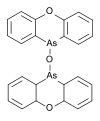 | 502.2318 | 58-36-6 | ||
| Triphenylarsine | Phenyl | 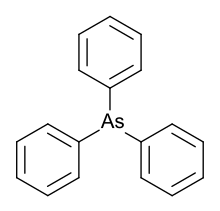 | 306.23 | 603-32-7 | Melting point 58-61 °C |
| Phenyldichloroarsine | phenyl, chlorine |  | 222.93 | 696-28-6 | |
| Roxarsone | 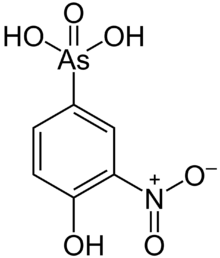 | 263.04 | 121-19-7 | ||
| Arsenobetaine | 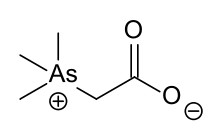 | 64436-13-1 | |||
| Arsenicin A | 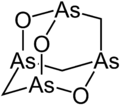 | 389.76 | 925705-41-5 | Melting point 182 to 184 °C (360 to 363 °F) | |
| Representative organoarsenic compounds [14][13] | |||||
Nomenclature
The naming of cyclic organoarsenic compounds is based on an extension of the Hantzsch–Widman nomenclature system[15] approved by IUPAC, as summarized below:[16]
| Ring size | Unsaturated ring | Saturated ring |
|---|---|---|
| 3 | Arsirene | Arsirane |
| 4 | Arsete | Arsetane |
| 5 | Arsole | Arsolane |
| 6 | Arsinine | Arsinane |
| 7 | Arsepine | Arsepane |
| 8 | Arsocine | Arsocane |
| 9 | Arsonine | Arsonane |
| 10 | Arsecine | Arsecane |
Because of its similarity to the English slang word "arsehole" (in common use outside North America), the name "arsole" has been considered a target of fun, a "silly name",[17][18] and one of several chemical compounds with an unusual name. However, this "silly name" coincidence has also stimulated detailed scientific studies.[19]
See also
- Arsenic biochemistry
- Arsenic poisoning
- Arsenic toxicity
- Category:Arsenic compounds
References
- Singh, R. Synthetic Drugs. Mittal Publications (2002). ISBN 817099831X
- Grund, S. C.; Hanusch, K.; Wolf, H. U. "Arsenic and Arsenic Compounds". Ullmann's Encyclopedia of Industrial Chemistry. Weinheim: Wiley-VCH. doi:10.1002/14356007.a03_113.pub2.CS1 maint: multiple names: authors list (link)
- Styblo, M.; Del Razo, L. M.; Vega, L.; Germolec, D. R.; LeCluyse, E. L.; Hamilton, G. A.; Reed, W.; Wang, C.; Cullen, W. R.; Thomas, D. J. (2000). "Comparative toxicity of trivalent and pentavalent inorganic and methylated arsenicals in rat and human cells". Archives of Toxicology. 74 (6): 289–299. doi:10.1007/s002040000134. PMID 11005674.
- Elschenbroich, C. "Organometallics" (2006) Wiley-VCH: Weinheim. ISBN 978-3-527-29390-2
- Reimer, K. J.; Koch, I.; Cullen, W. R. (2010). Organoarsenicals. Distribution and transformation in the environment. Metal Ions in Life Sciences. 7. Cambridge: RSC publishing. pp. 165–229. doi:10.1039/9781849730822-00165. ISBN 978-1-84755-177-1. PMID 20877808.
- Dopp, E.; Kligerman, A. D.; Diaz-Bone, R. A. (2010). Organoarsenicals. Uptake, metabolism and toxicity. Metal Ions in Life Sciences. 7. Cambridge: RSC publishing. pp. 231–265. doi:10.1515/9783110436600-012. ISBN 978-1-84755-177-1. PMID 20877809.
- Toshikazu Kaise; Mitsuo Ogura; Takao Nozaki; Kazuhisa Saitoh; Teruaki Sakurai; Chiyo Matsubara; Chuichi Watanabe; Ken'ichi Hanaoka (1998). "Biomethylation of Arsenic in an Arsenic-rich Freshwater Environment". Applied Organometallic Chemistry. 11 (4): 297–304. doi:10.1002/(SICI)1099-0739(199704)11:4<297::AID-AOC584>3.0.CO;2-0.
- Bentley, Ronald; Chasteen, Thomas G. (2002). "Microbial Methylation of Metalloids: Arsenic, Antimony, and Bismuth". Microbiology and Molecular Biology Reviews. 66 (2): 250–271. doi:10.1128/MMBR.66.2.250-271.2002. PMC 120786. PMID 12040126.
- Cullen, William R.; Reimer, Kenneth J. (1989). "Arsenic speciation in the environment". Chemical Reviews. 89 (4): 713–764. doi:10.1021/cr00094a002. hdl:10214/2162.
- Francesconi, Kevin A.; Edmonds, John S. (1998). "Arsenic Species in Marine Samples" (PDF). Croatica Chemica Acta. 71 (2): 343–359. Archived from the original (PDF) on 2008-03-09.
- John S. Edmonds, Kevin A. Francesconi, Jack R. Cannon, Colin L. Raston, Brian W. Skelton and Allan H. White (1977). "Isolation, crystal structure and synthesis of arsenobetaine, the arsenical constituent of the western rock lobster panulirus longipes cygnus George". Tetrahedron Letters. 18 (18): 1543–1546. doi:10.1016/S0040-4039(01)93098-9.CS1 maint: multiple names: authors list (link)
- Alice Rumpler; John S. Edmonds; Mariko Katsu; Kenneth B. Jensen; Walter Goessler; Georg Raber; Helga Gunnlaugsdottir; Kevin A. Francesconi (2008). "Arsenic-Containing Long-Chain Fatty Acids in Cod-Liver Oil: A Result of Biosynthetic Infidelity?". Angew. Chem. Int. Ed. 47 (14): 2665–2667. doi:10.1002/anie.200705405. PMID 18306198.
- Mancini, Ines; Guella, Graziano; Frostin, Maryvonne; Hnawia, Edouard; Laurent, Dominique; Debitus, Cecile; Pietra, Francesco (2006). "On the First Polyarsenic Organic Compound from Nature: Arsenicin a from the New Caledonian Marine SpongeEchinochalina bargibanti". Chemistry: A European Journal. 12 (35): 8989–94. doi:10.1002/chem.200600783. PMID 17039560.
- http://www.sigmaaldrich.com
- "Revision of the Extended Hantzsch-Widman System of Nomenclature for Heteromonocycles" at IUPAC, retrieved 29 Sept 2008
- Nicholas C. Norman (1998). Chemistry of arsenic, antimony, and bismuth. Springer. p. 235. ISBN 978-0-7514-0389-3. Retrieved 15 March 2011.
- Richard Watson Todd (25 May 2007). Much ado about English: up and down the bizarre byways of a fascinating language. Nicholas Brealey Publishing. p. 138. ISBN 978-1-85788-372-5. Retrieved 15 March 2011.
- Paul W May, Molecules with Silly or Unusual Names, publ. 2008 Imperial College Press, ISBN 978-1-84816-207-5(pbk). See also the Web page "Molecules with Silly or Unusual Names" at the School of Chemistry, University of Bristol, (retrieved 29 Sept 2008)
- M. P. Johansson; J. Juselius (2005). "Arsole Aromaticity Revisited". Lett. Org. Chem. 2: 469–474. doi:10.2174/1570178054405968.
Using quantum chemical methodology, we reinvestigate the aromaticity of the much debated arsole, using the newly developed gauge-including magnetically induced currents (GIMIC) method. GIMIC provides a quantitative measure of the induced ring current strength, showing arsole to be moderately aromatic.